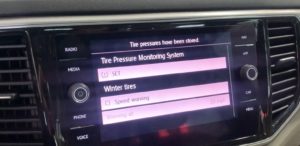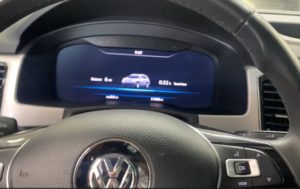Volkswagen Atlas TPMS Description
 The 2020 Volkswagen Atlas is equipped with a tire pressure monitoring system (TPMS) that alerts the driver when the pressure in one or more tires is too low. The Volkswagen Atlas uses its Anti-lock Brake System (ABS) sensors to indirectly check the tire pressure of the vehicle’s tires while moving.
The 2020 Volkswagen Atlas is equipped with a tire pressure monitoring system (TPMS) that alerts the driver when the pressure in one or more tires is too low. The Volkswagen Atlas uses its Anti-lock Brake System (ABS) sensors to indirectly check the tire pressure of the vehicle’s tires while moving.
How Does the Volkswagen Atlas TPMS work?
ABS sensors send signals to vehicle’s computer.
Computer calculates speed of each wheel.
Speed deviation caused by under-inflation detected.
ABS system compensates, triggers warning to driver.
Indicates low tire pressure.
Allows for early detection before becoming dangerous.
Indirect TPMS provides added safety layer.
ABS sensors are not directly designed to monitor the tire pressure in a modern vehicle, but they can be used as an indirect way to detect low tire pressure. The sensors send continuous signals to the vehicle’s computer, allowing it to calculate the speed of each wheel. The ABS system uses these speed calculations to detect when a wheel is about to lock up during braking. When a tire is under-inflated, it can cause the wheel to rotate at a different speed than expected. (The ABS sensors monitor the tread’s rolling circumference of each tire) This deviation in the wheel speed will affect the ABS system’s “expected” behavior and trigger a warning to the driver indicating that the tire pressure may be low. By using the wheel speed signals from the ABS sensors, the vehicle can detect changes in tire pressure without the need for additional sensors, this is known as indirect Tire pressure monitoring system (TPMS).
Volkswagen Atlas Tire Pressure Light Reset Procedure:
Turn the vehicle ignition ON.
Select VEHICLE
Then select SETTINGS
Select TIRES
Select SET in tire settings
Select CONFIRM when prompted “Do all four tire pressure readings comply with the required values.”
After, you will see a prompt that says “tire pressures have been stored”
What Happens When Tires are Under-Inflated?
 When tires are under-inflated, it can have a significant impact on the performance and safety of a vehicle. Under-inflation can cause the tire to wear out prematurely, reducing its lifespan and increasing the need for frequent replacements. Additionally, it can cause the tire to overheat, which can lead to a blowout or a loss of tire tread. (tread separation) Under-inflation also affects the vehicle’s handling and stability, as the contact patch of the tire is reduced, making it more difficult for the driver to maintain control of the vehicle. Under-inflated tires also create more rolling resistance, causing the engine to work harder, which in turn increases fuel consumption and emissions. As a result, it is very important to regularly check the tire pressure and maintain the recommended pressure levels for optimal vehicle performance and safety.
When tires are under-inflated, it can have a significant impact on the performance and safety of a vehicle. Under-inflation can cause the tire to wear out prematurely, reducing its lifespan and increasing the need for frequent replacements. Additionally, it can cause the tire to overheat, which can lead to a blowout or a loss of tire tread. (tread separation) Under-inflation also affects the vehicle’s handling and stability, as the contact patch of the tire is reduced, making it more difficult for the driver to maintain control of the vehicle. Under-inflated tires also create more rolling resistance, causing the engine to work harder, which in turn increases fuel consumption and emissions. As a result, it is very important to regularly check the tire pressure and maintain the recommended pressure levels for optimal vehicle performance and safety.
What Will Cause Tire Tread Circumference of a Tire to Change? (low pressure)
If a wheel was changed with a different size tire.
If a tires air pressure is to low or high,
If one side of the vehicle is heavier than the other. Or more weight on one axle than the other.
If there are snow chains on the tires. (snow chains will cause TPMS light to illuminate)
If a tire’s tread is damaged.
If a tire is structurally damaged.
Tire Maintenance
 Tires should always be adjusted when the tires are cold. Tires are affected by temperature changes, cold tires have lower pressure due to contraction, while hot tires have higher pressure due to expansion. The recommended tire pressure is based on cold tire measurements. Inflating hot tires can cause over-inflation, which can lead to a blowout or loss of tire tread. Cold tire measurements ensure accurate pressure levels, maintaining optimal vehicle performance and safety. It’s important to always check the tire pressure when the tires are cold, before driving or after the vehicle has been parked for a while.
Tires should always be adjusted when the tires are cold. Tires are affected by temperature changes, cold tires have lower pressure due to contraction, while hot tires have higher pressure due to expansion. The recommended tire pressure is based on cold tire measurements. Inflating hot tires can cause over-inflation, which can lead to a blowout or loss of tire tread. Cold tire measurements ensure accurate pressure levels, maintaining optimal vehicle performance and safety. It’s important to always check the tire pressure when the tires are cold, before driving or after the vehicle has been parked for a while.
